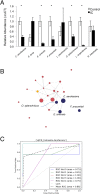Stool-based biomarkers of interstitial cystitis/bladder pain syndrome
- PMID: 27188581
- PMCID: PMC4870565
- DOI: 10.1038/srep26083
Stool-based biomarkers of interstitial cystitis/bladder pain syndrome
Abstract
Interstitial cystitis/bladder pain syndrome (IC) is associated with significant morbidity, yet underlying mechanisms and diagnostic biomarkers remain unknown. Pelvic organs exhibit neural crosstalk by convergence of visceral sensory pathways, and rodent studies demonstrate distinct bacterial pain phenotypes, suggesting that the microbiome modulates pelvic pain in IC. Stool samples were obtained from female IC patients and healthy controls, and symptom severity was determined by questionnaire. Operational taxonomic units (OTUs) were identified by16S rDNA sequence analysis. Machine learning by Extended Random Forest (ERF) identified OTUs associated with symptom scores. Quantitative PCR of stool DNA with species-specific primer pairs demonstrated significantly reduced levels of E. sinensis, C. aerofaciens, F. prausnitzii, O. splanchnicus, and L. longoviformis in microbiota of IC patients. These species, deficient in IC pelvic pain (DIPP), were further evaluated by Receiver-operator characteristic (ROC) analyses, and DIPP species emerged as potential IC biomarkers. Stool metabolomic studies identified glyceraldehyde as significantly elevated in IC. Metabolomic pathway analysis identified lipid pathways, consistent with predicted metagenome functionality. Together, these findings suggest that DIPP species and metabolites may serve as candidates for novel IC biomarkers in stool. Functional changes in the IC microbiome may also serve as therapeutic targets for treating chronic pelvic pain.
Figures





References
-
- Rabin C., O’Leary A., Neighbors C. & Whitmore K. Pain and depression experienced by women with interstitial cystitis. Women & health 31, 67–81 (2000). - PubMed
-
- Rothrock N. E., Lutgendorf S. K., Hoffman A. & Kreder K. J. Depressive symptoms and quality of life in patients with interstitial cystitis. J Urol 167, 1763–1767 (2002). - PubMed
Publication types
MeSH terms
Substances
Grants and funding
LinkOut - more resources
Full Text Sources
Other Literature Sources
Medical

